Designated Hitter is the Highest Paid MLB Position
If you were to examine the spectrum of defensive positions, going from easiest to most difficult, it would probably look something like this: Designated Hitter-First Baseman-Left Field-Right Field-Center Field-Third Base-Second Base-Shortstop-Catcher. Right field and left field are very similar and center field, second base, and third base are also bunched together under the typical spectrum. However, when looking for the positions that pay the most money, the positions that are the easiest to play make the most money. A similar point, in a similar fashion, was made last year at this time, and it remains true. A combination of the free agent system, aging, and the decline that puts the spectrum to use mean first basemen and designated hitters make the most money while shortstops tend to make the least when taking all starters into account.
I took every position player and designated hitter starter from our FanGraphs Depth Charts and put that alongside the salary information from Cot’s Contracts to find an average salary for the 30 starters at every position with the 15 starters at designated hitter. As was the case last year, first base and designated hitter make the most money, although this season, with Albert Pujols moving to designated hitter, first base lost its crown.

At first glance, it makes little sense to pay players at first base significantly more than at shortstop. They do not accumulate significantly more value over the course the season. However, all players are not acquired at similar costs. To make a lot of money in Major League Baseball, a player needs to hit free agency, and to hit free agency, a player needs at least six years of service time. We know that defensive peaks occur earlier, which means it will be more difficult for a very good defensive shortstop to hit free agency near his peak, while a player who relies less on defense is more likely to be viewed as still in his peak when he hits his first payday.
We also have the issue of players moving down the defensive spectrum. If the player is a good enough hitter to keep playing everyday, it is possible that moving down the fielding spectrum can keep the aging, more expensive player on the field. The simplest explanation is that power pays in free agency, and defensive deficiencies are excused on the free agent market.
Breaking things down by position, we can start with the designated hitter.
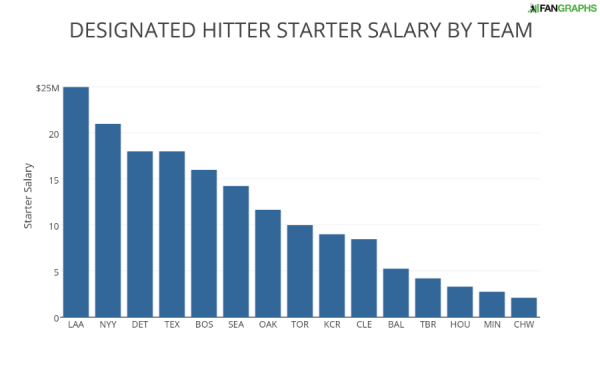
Every one of the players represented above started at a position other than designated hitter. Most began as corner outfielders or first baseman, but Alex Rodriguez, Albert Pujols, and Carlos Santana all entered the majors in more defensively difficult positions. First basemen are in a similar spot.

There are a lot more players here that started at first base, but around one-third of the players started at more strenuous positions, including the top name on the list, Miguel Cabrera, and five of the top 9 players.
We see about a 20% drop when moving from first base to the corner outfield positions.

Right field present an interesting scenario as it is one of two positions without a player making above $20 million (third base is the other), has almost one-third of the players making the minimum salary, yet still ranks as one of the most well-paid positions due to all the players making above $10 million. This should also serve as a reminder that Giancarlo Stanton is not yet one of those players due to his $300 million contract being so backloaded. Of those minimum-salaried players, George Springer, Miguel Sano, Mookie Betts, Stephen Piscotty, and Gregory Polanco represent a group that could find itself on the other end of the chart in a half-dozen years.
Left field looks fairly similar to right field.
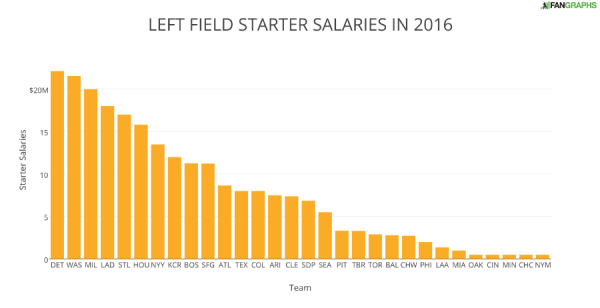
Newly signed Justin Upton leads the group followed by an aging group that includes Jayson Werth, Ryan Braun, Andre Ethier, and Matt Holliday. Kyle Schwarber and Michael Conforto headline the group at the lower end of the pay scale.
Third basemen represent another drop in pay as their firepower is stuck in arbitration.

Of the top 13 third basemen by FanGraphs projected WAR, only two (Adrian Beltre and Evan Longoria) have more than six years of service time, which is depressing the value of many of these players, especially Manny Machado, Josh Donaldson, Kris Bryant, and Nolan Arenado, the top four third baseman by the projections.
The next three positions–catcher, second base, and center field–are all close together right around $5.6 million. First, catcher:
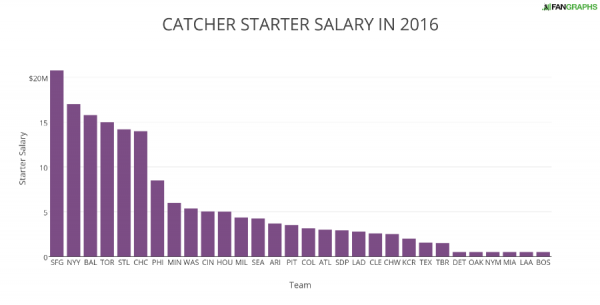
Catchers still have a handful of players making free agent money at the top, but the average salary is kept down by the bulk of players in the middle–half of the starting catchers will make between $2 million and $6 million for this season. Given the way catchers age, it is not surprising to see few large free agent contracts.
Center field salaries are kept down by the great number of players making the minimum this season.
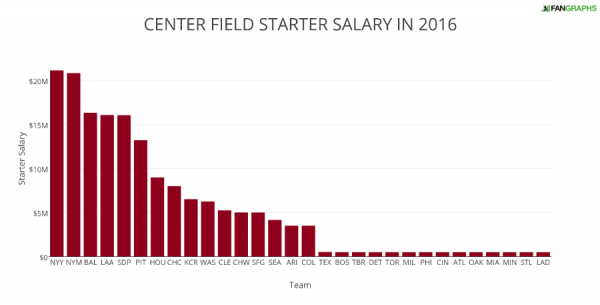
While New York sets the market, nearly half of the teams are using young, athletic, pre-arbitration players while they are likely in the prime of their defensive careers. While Joc Pederson and Randal Grichuk might eventually have to move off center field, defense-first players like Kevin Kiermaier and Kevin Pillar are also in the same group.
Second base has Robinson Cano at the top, but looks a lot more like catcher, with a large mid-priced middle section.

Second base is not the lowest of all positions. That honor goes to shortstops, where the average starter salary for this season is under $5 million.
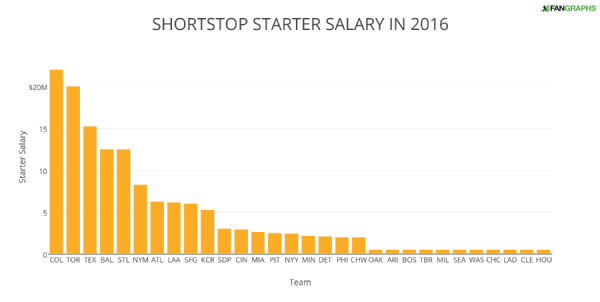
The top two players were traded for each other last season, and Colorado’s cost could come down depending on the outcome of Jose Reyes‘ domestic violence investigation. Shortstop is a young position, and younger positions do not get paid as much as veterans.
While first base pays roughly twice as much as the most important defensive positions when looking at all starters, the disparity is not as great at the top. If we looked at just the top 20% of salaries for position players, first base is at the top with $24 million, but the gap percentage-wise is not as great, with all of the other positions coming in between $14 million and $20 million. If those younger players making the minimum and going through arbitration are still playing at a high level when they reach free agency, they should have little problem cashing in.
Craig Edwards can be found on twitter @craigjedwards.

hmmm, seems like DH is highest-paid mostly because arb and pre-arb players are not slotted into the DH role… not sure you’d get the same result if you adjusted this analysis for FA versus arb versus pre-arb….